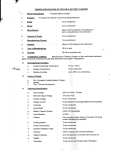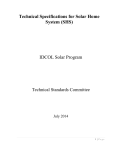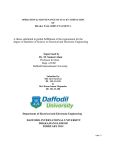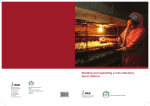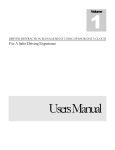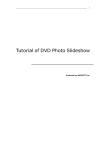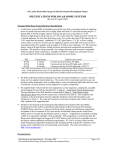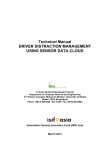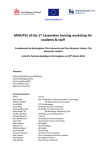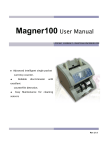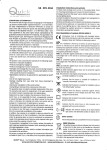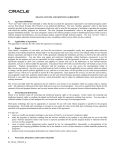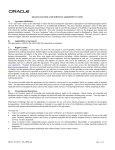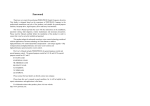Download Technical Specifications for Solar Home Systems (SHS)
Transcript
Technical Specifications for Solar Home System (SHS) Rural Electrification and Renewable Energy Development (PV Component) Project (REREDP) Technical Standards Committee October 7, 2002 October 7, 2002 Mr. M. Ziaul Islam Choudhury Chairman Rural Electrification Board (REB) Joar Sahara, Khilkhet Dhaka 1229, Bangladesh Dr. M. Fouzul Kabir Khan Executive Director and CEO Infrastructure Development Company Limited IDB Bhaban (6th Floor) Begum Rokeya Sarani, Agargaon Dhaka 1207, Bangladesh Subject: Report on Technical Specifications for Solar Home System (SHS) Dear Sirs: Here is the report on technical specifications for solar home system (SHS). As you are aware that TSC was formed with the view to propose technical specifications for photo-voltaic modules and other SHS components to be promoted under International Development Association and Global Environment Facility (GEF) funded Rural Electrification and Renewable Energy Development (PV Component) Project (REREDP). While setting the specifications, the Committee reviewed similar specifications that have been adopted in other countries and took the country specific, e.g., Bangladesh conditions in account. It believes the specifications formulated are adequate to successfully promote and popularize SHS in Bangladesh. Should you require any clarification on this report, please do not hesitate to contact me. Best regards. Sincerely yours, Dr. M. Rezwan Khan Chairman, TSC Preamble The purpose of this report is to set forth technical specifications for photo-voltaic modules and other solar home system (SHS) equipment to be promoted under International Development Association and Global Environment Facility (GEF) funded Rural Electrification and Renewable Energy Development (PV Component) Project (REREDP). The RERED project is to be implemented in two phases: the Pilot phase (April-October, 2002) and the main phase (October 2002-October 2008). The Project follows a twin-track approach. The two executing agencies, Infrastructure Development Company Limited (IDCOL) and Rural Electrification Board (REB), shall be implementing their “Ownership/Direct Sales” and “Fee-for-Service” models respectively. Under the Pilot program, already underway, IDCOL is financing 250 SHSs through five participating organizations; while, REB is promoting 150 SHSs through its six Palli Bidyut Samitis (PBSs). Under the main program, IDCOL shall promote 50,000 SHSs; while, REB promote 14,000 SHSs. SHS components those qualify under this technical specification will be eligible for procurement of this project. Because of difference in delivery mechanism of REB and IDCOL, they will follow their own tendering, evaluation and procurement procedure. The standard specification will be revised and updated by the Technical Standard Committee during the implementation period of the Project as new technology and products emerge. SHS Specifications for Bangladesh - -1 Technical Standards for Solar Home System in Bangladesh 1. Solar Home System Hardware Description 1.1 The Solar Home System (SHS) is intended to provide the user with a convenient means of supplying power for small electrical loads such as lights, radio/cassette players or TV. A typical SHS operates at a rated voltage of 12 Vdc and provides power for fluorescent luminaires, radio/cassette players, small black and white TV or similar low-power appliance for about three to five hours a day. Additionally, other types of luminaires, 12 Vdc or lower voltage DC/DC converter outlets or a DC/AC inverter may be supplied as options. Each SHS consists of one or more photovoltaic (PV) modules, each having minimum output of 30 Wp charging a 12 Vdc lead-acid battery along with luminaires, related electronic and electrical components and mounting hardware. 1.2 The system should be designed to have at least three days autonomy (i.e. can run for three consecutive days without charging from the panel). 1.3 The SHS is packaged to provide convenient installation at a remote customer home site by a qualified technician. The system is constructed such that a user can perform routine maintenance such as adding battery water and replacing light bulbs and fuses, and a technician can easily perform system diagnostics or replace components. 2. Certification Requirements 2.1 Products to be financed by the IDA and Global Environment Facility (GEF) under Rural Electrification and Renewable Energy Development (PV Component) Project (REREDP) t must have a type-test certificate from an accredited testing and certification organization as elaborated in Annex – 1. For local products, a certification from a reputed institution like Bangladesh University of Engineering and Technology, Dhaka, is acceptable. In case the purchasing authority feels they may ask for sample test of any component from Bangladesh University of Engineering and Technology, Dhaka or any other reputed institution. 2.2 The supplier provides the most appropriate system integration, components, assembly and packaging that meet all the component specifications in 'Annex 1 - Solar Home System Component Specifications' and the 'Recommended Practices' described below. 3. Recommended Practices This section provides a minimum set of requirements that shall be followed in the design, specification and installation of the qualified SHS. They form a set of “Recommended Practices” which when followed will ensure adequate levels of safety, performance, reliability and system lifetime. SHS Specifications for Bangladesh - -2 4. PV Module Installation PV module installation refers to the following: (a). If more than one module is used, identical models shall be used and they shall be connected in parallel. (b). For SHS installed permanently on a structure (in contrast with portable units): i. The modules must ensure waterproof sealing for the solar cells. Modules must be framed in such a way as to allow secure connection to the module mounting structure. ii. The mounting structure will hold the photovoltaic module(s). The module(s) must be mounted on a support structure made of corrosion resistant material that assures stable and secure attachment. iii. The PV array and support structure must be able to withstand wind gusts up to 160 km/hour without damage. iv. The structure must be mounted at a fixed angle and oriented to maximize the useful energy supplied to the user over the year (for Bangladesh, the panel should be facing south with a tilt angle of around 23o with the horizon). v. The structure will incorporate corrosion resistant hardware for all external connections. vi. The modules can be roof or ground-mounted: In case of Roof-mounted modules, minimum clearance between the PV module and the roofing material must be at least 20 cm above the roofing material. It is recommended that the module mounting structure be supported on top of a pole of at least 50 cm length. Anchoring of the mounting structure must be to the building and not to the roofing material. For ground-mounted modules, a metal, concrete or treated wood pole must be used with the modules attached at the top of the pole. The modules must be at least 4 meters off the ground. The pole must be anchored in concrete or tightly packed soil at least one meter deep in the ground. The pole and mounting structure must be sufficiently rigid to prevent twisting in the wind or if large birds alight on the module. The panel should be mounted clear of vegetation, trees and structure so as to assure that they are free of shadow throughout day light hours during each season of the year. Furthermore, if more than one panel is mounted on a support structure the panels should not be mounted such that one panel will not shade the other module(s). 5. Circuit Protection and Charge Controls Circuit protection and charge controls include the following: (a). Systems must include a means to protect users and system components from the following: SHS Specifications for Bangladesh - -3 i. Battery overcharge and excessive water loss. ii. Battery undercharge and excessive discharge. iii. Circuit protection against short circuit of any load. iv. Circuit protection against reverse polarity of module or battery. v. Circuit protection against internal shorts in charge controller, inverter or other devices. vi. Circuit protection against damage by the high PV open circuit voltage when it is connected to the controller without battery. vii. Night time discharge of the battery due to reverse current through the module. (b). Systems will provided appropriate protection by a charge controller incorporating a high voltage disconnect (HVD), low voltage disconnect (LVD) and circuit protection. 6. System Monitoring System monitoring includes the following: (a). A display to indicate when the battery is in the charging mode must be provided. (b). This device must, at a minimum, indicate when the battery condition is: i. Suitable to operate loads ii. Energy conservation required (c). The chosen device must come appropriately labeled such that the user does not have to refer to a manual to understand the existing battery condition. 7. Batteries Recommended practices for batteries include the following: (a). Batteries should be selected to offer at least five years of useful life. (b). The minimum size of the battery should be 50Ah@10 hours. (c). The batteries can be supplied in a dry-charged condition and all chemicals and electrolyte must be supplied in accordance with battery supplier specifications. The battery and associated containers should be packaged to handle transport down rough roads. 8. Equipment Enclosure With regard to equipment enclosure, recommended practices comprises the following: (a). The batteries and charge controller should be kept in properly designed protective enclosures. (b). The batteries must be housed in a vented compartment. All parts of the compartment subject to battery acid contact must be acid resistant. This compartment must be built strong enough to accommodate the weight of the battery. This compartment must SHS Specifications for Bangladesh - -4 adequately support and vent wet lead-acid batteries. Access to the battery compartment by children must be prevented. 9. Wiring Wiring practices include the following: (a). Stranded and flexible insulated copper wiring must be used. Minimum acceptable crosssection of the wire in each of the following sub-circuits are as follows: (i) From PV module to Charge Controller : 2.5 sqmm (ii) From Charge Controller to battery : 4.0 sqmm (ii) From Charge Controller to Socket Out-let : 4.0 sqmm (iv) From Charge Controller to all other loads : 1.5 sqmm. (b). Notwithstanding the above minimum wire size requirements, all wiring must be sized to keep line voltage losses to less than 3% in each sub-circuit and to allow the circuit to operate within the ampacity rating of the wire. (c). For SHS permanently installed on a structure, all exposed wiring (with the possible exception of the module interconnects) must be in conduits or be firmly fastened to the building structure. Wiring through roofing, walls and other structures must be protected through the use of bushings. Wiring through roofing must form a waterproof seal. (d). Field-installed wiring must be joined using terminal strips or screw connectors. Soldering or crimping in the field must be avoided if at all possible. Wire nuts are not allowed. The rated current carrying capacity of the joint must not be less than the circuit current rating. All connections must be made in junction boxes. Fittings for lights, switches, and socket outlets may be used as junction boxes where practical. 10. Documentation The component specifications should be summarized by the interested supplier in the form attached in Annex 2 - Solar Home System Specification Data Sheet along with the required test certificates. Any exceptions and variations to the specifications must be explicitly stated in a section entitled Exceptions and Variations in Annex 2. The scope and reasons for each listed exception and variation must be fully explained with supporting data. 11. Users Manual 11.1 For IDCOL The solar home system (SHS) supplier must provide a User’s Manual intended for the customers and will be included with each of the packaged systems. The manual must be in Bangla. The User’s Manual documentation should be simple and easy to understand. Use of sketches or graphics should be used to make the manual easier to use. The documentation is to include the following: (a). How the SHS works: battery charging by the array, functions, battery low voltage protection, and battery overcharge protection. The relationship between energy available on a daily basis and sunlight conditions should be clearly and simply explained. (b). A description of all user interactive hardware including disconnect switches and status indicators. (c). Procedures for proper system operation, including a list of load limitations and any problem loads. These procedures should include suggested operation, including load SHS Specifications for Bangladesh - -5 conservation, during periods of inclement weather, and/or a low voltage disconnect event. The procedures for checking that the photovoltaic array is not shaded and how to prevent shading must be explained. (d). Any user maintenance items. (e). Emergency shut down procedures and recommendations for extended periods of system non-use. (f). A user trouble-shooting guide. (g). A block diagram showing the main components. 11.2 For REB To be developed by REB/PBSs and their consultants. 12. Technicians/Technical Manual 12.1 For IDCOL The supplier must provide a Technician’s Installation, Operations and Maintenance Manual to be used by the service technicians. The manual must be in Bangla. The manual will include the specific details on installation, operation and maintenance, such as: (a). A detailed technical description of the system. (b). A complete copy of the Users Manual. (c). A complete list of all system components, with associated manufacturers literature, specifications, and warranties. (d). Complete installation instructions. (e). Recommended post-installation acceptance test procedures, including all appropriate set points and test procedures. They will include: i. ii. iii. iv. v. Verify that the installation of the photovoltaic array with regard to position, direction, inclination and shading avoidance will maximize energy generation. Test all of the loads for proper operation. Make system-wide voltage drop measurements in the sub-circuits to verify that connections meet the required maximum allowable voltage drop. Note all measurements in the installation log. Explain to the user the system operating principles, load management requirements, impact of shading of the array and how to check and avoid it, user maintenance checks and how to conduct them. (f). A recommended annual maintenance schedule, with complete maintenance instructions. (g). A functional block diagram, electrical single-line drawing showing the placement of all hardware and ratings of all component and physical layout diagram. (h). Emergency shut down procedures. SHS Specifications for Bangladesh - -6 12.2 For REB The supplier must provide technical/user manual, which will include detailed technical specification, circuit diagram, installation, operation and maintenance details. Number of such manuals to be mentioned by REB on the basis of requirement. 13. Packaging and Delivery 13.1 For IDCOL 13.1.1 The SHS supplier must obtain the PV system equipment and components, assemble and wire them into integrated packaged SHS in accordance with the proposed design, and deliver the packaged SHS to the user. 13.1.2 Each system must be packaged for shipping to prevent any shipping related damage. The supplier will be responsible for settling any shipping related damaged claims and will be responsible for replacing damaged systems in a timely manner. 13.2 For REB Packaging and delivery of materials is to be followed as per REB requirement to be mentioned in bid document. 14. Maintenance The supplier must have the manpower and technical capability to trouble shoot and maintain the systems installed. In case of Rural Electrification Board (REB)/Palli Bidyut Samitis (PBSs) solar program, operation and maintenance will be done by the REB/PBSs staff. SHS Specifications for Bangladesh - -7 Annex 1 Solar Home Systems Component Specifications 1. General 1.1. The supplier will provide at a minimum of six-month warranty against manufacturers defects on all system integrated parts and labor excluding fuses or end-use devices such as luminaire or lamps. On all major individual components, manufacturers’ warranties will be passed through to the user for IDCOL. For REB, such warranties will be passed through to REB/PBSs. Specifically, the PV modules should be warranted for at least twenty (20) years and must not experience more than 20 percent of rated capacity reduction in output over its lifetime. The charge controller, switches-socket and other accessoriesappliances should be warranted for at least three years. The pole mount module supporting structure set with fitting and fixture should be warranted for 10 years. The battery should be warranted for at least five (5) years. Battery end-of-life will be determined when the battery capacity down to 1.75 V/cell at 250C drops to less than 80 percent of the initial rated capacity. All warranties become effective from the day the system is accepted by the user for IDCOL and from the date of acceptance for REB. 1.2. Nominal system voltage (rated voltage) shall be 12 Vdc. 1.3. The main components should be integrated in such a way as to allow replacement (in case of failure) with a similarly functioning component of a newer design or a different brand. This will allow for future component evolution or variability of future component availability. All components, including spares, will undergo full bench testing at the supplier factory or the originating source factory with proper documentation supplied. All electrical settings (voltages, current, etc.) will be verified and documented with the results dated and the records maintained at the suppliers facility. 2. Operating Environment 2.1. The entire system shall be designed and built to withstand the environmental conditions prevail in Bangladesh. For design purposes, temperature extremes ranging from +50C to +450C and humidity levels above 90 percent should be considered. 2.2. All wiring, enclosures, and fixtures that are mounted indoors must be resistant to high humidity conditions, corrosion, insect, and dust intrusion. 3. Photovoltaic Module The following are applicable standards for PV modules: • International Electrotechnical Committee (IEC) 61215: Crystalline Silicon Terrestrial PV Modules Design Qualification and Type Approval SHS Specifications for Bangladesh - -8 • • • IEC 61646: Thin Film Silicon Terrestrial PV Modules Design Qualification and Type Approval IEC 60904-1: Photovoltaic Devices Part 1 Measurement of PV CurrentVoltage Characteristics IEEE 1262: Recommended Practice for Qualification of Photovoltaic Modules PV GAP Recommended Standards are preferred. 3.1 The photovoltaic array will consist of one or more flat-plate photovoltaic modules. Each module should comprise of no less than 36 series-connected single or poly-crystalline silicon solar cells. Flat plate thin-film modules could also be used. 3.2 The photovoltaic module should have a peak power output of at least 30 Wp. 3.3 All modules must be product tested and certified. 3.4 Each module must be factory equipped with weather-proof junction box with terminal strip that allows safe and long lasting wiring connection to the module. Where applicable, protective diodes should be used to avoid the effect of partial shading. 3.5 Each module must be labeled indicating at a minimum: Manufacturer, Model Number, Serial Number, Peak Watt Rating, Voltage and Current at peak power, Open Circuit Voltage and Short Circuit Current of each module. 4. Battery Storage 4.1 The battery should be 12V block, rechargeable flooded lead-acid battery (Lead-antimony grid), heavy duty plate construction, deep-cycle, tubular positive plate should include explosion-proof safety vent, carrying handle. Only deep-cycle batteries will be considered, no sealed battery will be accepted. 4.2 The maximum permissible self-discharge rate is 5 percent of rated capacity per month at 250C. 4.3 Cycle life of the battery (i.e., before its residual life drops below 80 percent of the rated Ah capacity), at 250C must exceed 1500 cycles when discharged down to an average depth of discharge (DOD) of 75 percent at the discharge rate of 10 hours. 4.4 The positive plate must be of tubular type. 4.5 The inter-cell connection should not be exposed. 5. Charge Controller 5.1. The charge controller set points must be factory preset with the set points applicable to the specified battery characteristics. 5.2. The charge controller must be capable of handling 130% of the module's rated short circuit current for one-hour duration. 5.3. Maximum current draw of the controller, when no LED’s are lit should not exceed 20 mA. 5.4. The model number, serial number, rated voltages and currents, and set points should be noted on the charge controller case. 5.5. Battery, high voltage disconnect 14.3±0.2 volts, or as specified by the supplier. SHS Specifications for Bangladesh - -9 5.6. Reverse current leakage protection is recommended. Blocking diodes or logic-derived methods are both acceptable. If blocking diodes are used they must exhibit a low forward voltage drop. 5.7. The SHS must be protected against damage caused by short circuit of the input and output terminals, and reverse polarity of connections. Over-current protection must be provided. Lightning induced surge protection is recommended. 5.8. Some means must be provided to safely disconnect the battery and the module during servicing or repair by a technician. 5.9. The load must be controlled by a low voltage disconnect (LVD) device. The LVD must be capable of handling at least 150 percent of the maximum expected continuous load (e.g., assuming all end use devices are simultaneously on). It should be factory preset to disconnect and reconnect voltages corresponding to the safe operation of the battery under ambient temperature conditions. For example, a disconnect voltage of 11.6 Vdc +/- 0.1 Vdc and reconnect voltage of 12.6 Vdc +/- 0.2 Vdc is suitable. 6. Fluorescent Lamp Set Each fluorescent luminaire should have its own inverter (ballast). 6.1. The rated efficiency of the fluorescent lamp must be maintained over the range of minus 2.5% to plus 20%, i.e.,–2.5% to +20% of the rated capacity. 6.2. The inverter electrical efficiency must be greater than 80 percent from 11.0 to 13.3 V when using the fluorescent lamp specified by the supplier. 6.3. The minimum operating voltage when the tube will strike (start) should be at least 90% of the rated input voltage when using the fluorescent lamp specified by the supplier. 6.4. Maximum continuous operating voltage without damage to the inverter circuit must be at least 125% of the rated voltage. 6.5. The minimum operating frequency should be 20 kHz. 6.6. The electrical waveform at the fluorescent lamp terminals must be symmetrical in time to within 10 percent over the voltage range of 11.0 to 12.5 Vdc at an ambient temperature of 25 degree C. 6.7. The maximum crest factor (ratio of maximum peak to RMS voltage of the waveform applied to the fluorescent lamp) must be less than 2. 6.8. The input connections to the inverter should prevent the application of voltage with reverse polarity, or the inverter should be protected against damage when the rated voltage is applied with reverse polarity. 6.9. The inverter should be protected against damage by the application of voltage under open circuit conditions (e.g., when the light bulb is removed or has failed). The maximum input current draw under open circuit conditions should be no more than 200 mA. 6.10. Inverter or the luminaire must be marked with the manufacturer, model number, rated voltage, wattage and date of manufacture or batch number. SHS Specifications for Bangladesh - 10 - 6.11. The lamps should have the efficacy of at least 35 lumen/watt and a minimum warranty of one (1) year. 6.12. The ballast must be warranted for at least three (3) years. 7. Socket Outlet 7.1 A 12 Vdc socket outlet for a radio/cassette player, TV or similar appliance must be rated to carry the maximum expected DC current. The outlet must be protected from reversing the polarity of the voltage applied to the appliance. SHS Specifications for Bangladesh - 11 - Annex -2 Solar Home System (SHS) Specification Sheet Photovoltaic Module(s) (a) Model number_______________________________________________________________________ (b) Type (a-Si, Mono/Poly Crystalline Si, etc.)________________________________________________ (c) Number of cells in series_______________________________________________________________ (d) Open circuit voltage (Voc)__________________________________________________________V (e) Short circuit current (Isc)_____________________________________________________________A (f) Rated peak power (Pmax) __________________________Wp at STC, (Standard Testing Conditions) (g) V max____________________________________________________________________________V (h) I max_____________________________________________________________________________I (i) NOCT (Nominal Operating Cell Temperature) _____________________________________deg C • Short Circuit Current Temp. Co efficient ________________________________________mA/oC • Open Circuit Voltage Temp. Co efficient ________________________________________mA/oC • Frame: The laminate should be fitted with a corrosion and torsion resistant anodised aluminium frame with extremely high mechanical stability and convenient mounting access. • JUNCTION Box: Weatherproof, suitable cable entry inlets/outlets, external grounding screw, +ve and -ve terminal mark, UL/IEC certification. (j) Test certification standard______________________________________________________________ (k) Test laboratory______________________________________________________________________ (Please attach I-V Curve and copy of test certificates, if not supplied already.) Support Structure (a) Type______________________________________________________________________(roof/pole) (b) Wind velocity withstand capacity __________________________________________________ km/h (c) Material____________________________________________________________________________ Battery Storage (a) Model number_______________________________________________________________________ (b) Nominal voltage ___________________________________________________________________V SHS Specifications for Bangladesh - 12 - • Battery low voltage _____________________________________________________________V • Battery Gassing Voltage _________________________________________________________V • Max. Charging Current (Continuous) _______________________________________________A • Max. Discharging Current (Continuous) _____________________________________________A (c) Structure and material of positive plate ___________________________________________________ (i) Positive plate thickness _____________________________________________________mm (ii) Negative plate thickness ____________________________________________________mm (d) Capacity per battery at C/10 down to 1.75/cell ___________________________________________Ah (e) Self discharge rate ___________________________________________________________(%/month) (f) Cycle life down to 75 percent of DOD ___________________________________________________ (g) Electrolyte volume _______________________________________________________________liters (h) Certified to standard ______________________________________________ : ___________(Yes/No) (Please attach I-V Curve, Temp. Effect on Battery and copy of test certificates, if not supplied already.) Charge Regulator and Load Control (a) Model number ______________________________________________________________________ (b) Rated voltage ______________________________________________________________________V (c) High voltage disconnect (i) Voltage regulation set point (Vr) ____________________________________________________ (ii) Reconnect voltage (Vrr) ___________________________________________________________ (d) Charging indicator? ___________________________________________________________(Yes/No) • Battery Status___________________________________________________________ • Charging Status __________________________________________________________ • System Connection status ___________________________________________________ • Other (specify) __________________________________________________________________ (e) Maximum current handling capacity ___________________________________________________A (f) Type of current leakage protection ______________________________________________________ (g) Voltage drop between module and battery terminals at controller/regulator _____________________V (h) Temperature compensation? ____________________________________________________(Yes/No) SHS Specifications for Bangladesh - 13 - (i) LVD maximum current handling capacity _______________________________________________A (j) LVD set points (i) Disconnect voltage ______________________________________________________________V (ii) Reconnect voltage ______________________________________________________________V (k) Current draw with and without LEDs ________________________, mA _____________________mA (l) Short circuit protection? _______________________________________________________(Yes/No) (m) Reverse polarity protection? ____________________________________________________(Yes/No) (n) Electronic over current protection ________________________________________________(Yes/No) (o) Lightening surge protection? ____________________________________________________(Yes/No) (Please copy of test certificates, if not supplied already.) System Monitoring (a) Battery State-of-Charge indicator? _______________________________________________(Yes/No) (b) Type of indicator ____________________________________________________________________ (c) Indicator settings (i) Fully charged suitable to use ______________________________________________________V (ii) Energy conservation _____________________________________________________________V (iii) Other (explain) __________________________________________________________________ Equipment Enclosure (a) Type of battery enclosure • Material ________________________________________________________________________ (b) Type of controller housing _____________________________________________________________ • Material ________________________________________________________________________ (c) Protection method against battery acid/fumes etc. ___________________________________________ Wiring (a) Wire material type ___________________________________________________________________ Wire cross-sections (b) PV module to controller ___________________________________________________________mm2 • Voltage loss factor ____________________________________________________volt/amp/foot • Insulation type ___________________________________________________________________ SHS Specifications for Bangladesh - 14 - (c) Controller to battery ______________________________________________________________mm2 • Voltage loss factor ____________________________________________________volt/amp/foot • Insulation type ___________________________________________________________________ (d) Controller to loads_______________________________________________________________ mm2 • Voltage loss factor ____________________________________________________volt/amp/foot • Insulation type ___________________________________________________________________ Lengths of wired supplied? _______________________________________________________________ Lighting Fixtures (a) Number of fixtures ___________________________________________________________________ (b) Number of fluorescent (CFL/TFL) lights _________________________________________________ For fluorescent lights: (c) Model number(s) ____________________________________________________________________ (d) Wattage(s) _______________________________________________________________________W (e) Lumen output(s) ___________________________________________________________________L (f) Luminous efficacy _______________________________________________________________L/W (g) Minimum striking voltage ____________________________________________________________V (h) Maximum continuous operating voltage _________________________________________________V (i) Operating frequency _____________________________________________________________kHz (j) Electrical waveform voltage symmetry ___________________________________________________ (k) Maximum crest factor ________________________________________________________________ (l) Open circuit voltage protection? _________________________________________________(Yes/No) (Please attach copy of test certificates, if not supplied already.) Socket Outlet (a) 12 Vdc socket outlet? _________________________________________________________(Yes/No) (b) Reverse polarity protection? ____________________________________________________(Yes/No) (c) 6 and/or 9 V outlet? ___________________________________________________________(Yes/No) Other Components/Features (a) ___________________________________________________________________________________ (b) ___________________________________________________________________________________ (c) ___________________________________________________________________________________ SHS Specifications for Bangladesh - 15 - (d) ___________________________________________________________________________________ (e) ___________________________________________________________________________________ Exceptions and Variations to the Specifications Taken and Explanations (a) ___________________________________________________________________________________ (b) ___________________________________________________________________________________ (c) ___________________________________________________________________________________ (d) ___________________________________________________________________________________ (e) ___________________________________________________________________________________ SHS Specifications for Bangladesh - 16 - Annex 3 Terms of Reference Introduction International Development Association and Global Environment Facility (GEF) funded Rural Electrification and Renewable Energy Development (RERED) Project combines rural electrification and business development. It encompasses the installation of around 64,000 Solar Home Systems (SHSs) in various modes of use through a number of agents. The program will be implemented and coordinated by REB and IDCOL and will be executed by selected Palli Bidyut Samitis (PBSs), Microfinance Institutions (MFIs)/Non-government Organizations (NGOs), and other private entities. To determine the technical standards for solar photovoltaic (PV) panels and other hardware equipment under the REREDP, a Technical Standards Committee (TSC) is to be formed. The Committee comprises representatives from Bangladesh University of Engineering and Technology (BUET), Local Government Engineering Department (LGED), REB, and IDCOL (the list of TSC members is shown in Annex 4). Objectives The main objectives of this TSC are: • • • • • • • • Prepare technical specifications for the SHS and renewable energy equipment; Set up a database of technical information of products (systems and components) that qualify for the program; Assist manufacturers and suppliers to participate in the program; Assist local actors (NGOs, REB) in qualification of manufacturers and suppliers; Develop and execute regular sample quality checks on systems installed; Keep track of technological and product developments, at least over the period of 4 to 5 years in which the program is expected to actively purchase products Operate on a rather intensive basis during the Phase 1 of the program (February - October 2002), in which all procedures for procurement will be put in place, including the qualification of suppliers and their product ranges and during which the first systems will be purchased. Convene on an extensive basis during Phase 2 (October 2002 – October 2008) on the basis of 'ifand-when required'; execute periodical sample tests on newly purchased systems as well as postinstallation monitoring. SHS Specifications for Bangladesh - 17 - Annex 4 List of TSC Members SL Name Designation 1. Dr. M. Rezwan Khan, Professor, Chairman Department of Electrical Electronics Engineering, BUET 2. Mr. Syed A. F. M. Sajedul Huq, Executive Member Engineer, Renewable Energy Cell, REB 3. Mr. Mohammed Kaiser Rashid, Assistant Member Engineer, REB 4. Mr. Tazmilur Rahman, Project Manager, Member SRE Project, LGED 5. Mr. Sk. Munir Ahmad, RET Expert, SRE Member Project, LGED 6. Mr. Rahat Jaman, Investment Officer, Member-Secretary IDCOL SHS Specifications for Bangladesh Signature - 18 -




















